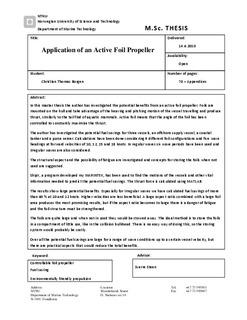Application of an Active Foil Propeller
Master thesis
Permanent lenke
http://hdl.handle.net/11250/237720Utgivelsesdato
2010Metadata
Vis full innførselSamlinger
- Institutt for marin teknikk [3421]
Sammendrag
In this master thesis the author has investigated the potential benefits from an active foil propeller. Foils are mounted on the hull and take advantage of the heaving and pitching motion of the vessel travelling and produce thrust, similarly to the tail find of aquatic mammals. Active foil means that the angle of the foil has been controlled to constantly maximise the thrust.
The author has investigated the potential fuel savings for three vessels, an offshore supply vessel, a coastal tanker and a purse seiner. Calculations have been done considering 9 different foil configurations and five wave headings at forward velocities of 10, 12, 15 and 18 knots. In regular waves six wave periods have been used and irregular waves are also considered.
The structural aspect and the possibility of fatigue are investigated and concepts for storing the foils when not used are suggested.
ShipX, a program developed my MARINTEK, has been used to find the motions of the vessels and other vital information needed to predict the potential fuel savings. The thrust force is calculated using MATLAB.
The results show large potential benefits. Especially for irregular waves we have calculated fuel savings of more than 60 % at 10 and 12 knots. Higher velocities are less beneficial. A large aspect ratio combined with a large foil area produces the most promising results, but if the aspect ratio becomes to large there is a danger of fatigue and the foil structure must be strengthened.
The foils are quite large and when not in used they would be stowed away. The ideal method is to store the foils in a compartment of little use, like in the collision bulkhead. There is no easy way of doing this, so the storing system would probably be costly.
Over all the potential fuel savings are large for a range of wave conditions up to a certain vessel velocity, but there are practical aspects that would reduce the total benefits.
